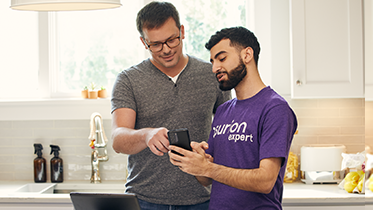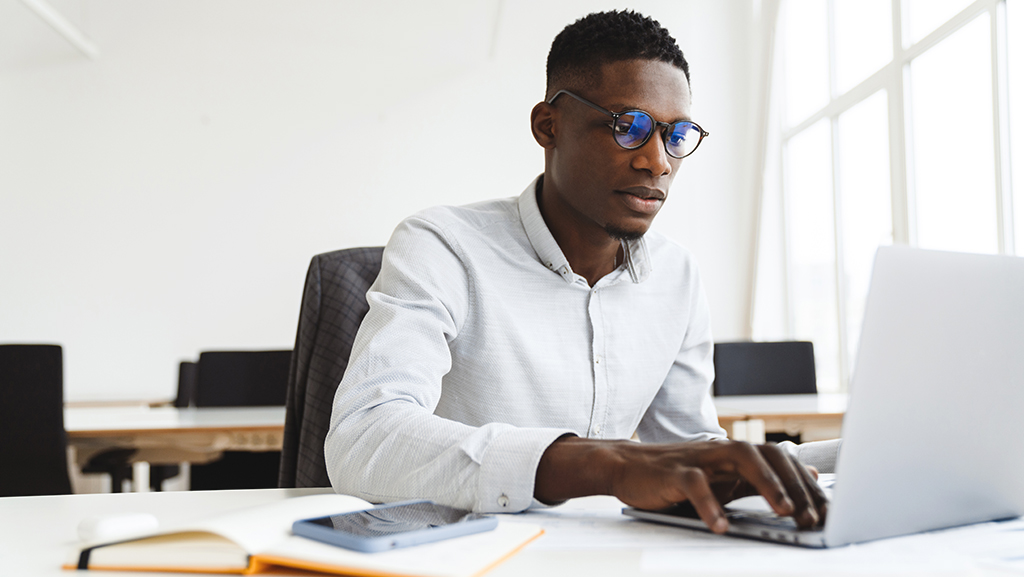Our phones can do almost anything: video conferencing, social media-scrolling, note-taking, and more. But laptops—with their keyboards and bigger screens—still come in handy. What type of laptop you need, however, depends on what you need to do. Are you a gamer? An expert photo editor? Or maybe just a casual email-checker? Either way, we've got you covered.
Here at Asurion, we not only fix and protect your tech, we help you decide what devices are right for you. Here's how to determine the perfect laptop for you.
Wants and needs
The first thing to consider when buying a laptop is who is going to use it and why. Computer manufacturers make their devices for specific types of people. A student might need more portability than, say, a stay at home parent. A video editor who works from home might need more processing power than someone that uses a laptop for basic tasks. Make a list and stay in touch with what you need.
Budget
Another important thing to think about is your budget. A laptop is a big purchase. There's no use in buying the most expensive laptop on the market if you won't use all of its features. The average price of an entry-level PC is about $250, with fully loaded gaming laptops coming in around $2,000. A MacBook® starts at $999, and that's with only the most basic features.
Operating system
You might see a few laptops with different operating systems, and knowing which one is right for you can feel overwhelming. Here are some of the most popular ones and what they have to offer.
Windows
Great for everyday use and powerful gaming. Windows™ has something for everyone. It's a good choice for those who want to use their laptop just for checking emails and surfing the internet easily. But if you want to upgrade, you can easily use Windows to create a powerful gaming computer.
iOS
Great for photo/video editing and music production. iOS®, Apple's operating system, favors media creators—from musicians to graphic designers. If those are your goals, a MacBook® might be the laptop for you. Another benefit: If you have an iPhone®, and know how to use it, using iOS will be seamless, and might even save you time if you need tech support.
ChromeOS
Fast and simple. The Chromebook™ is a small, basic laptop that uses the Google® operating system. It's a great device if you're doing basic word processing, email-checking, and web surfing. Plus, if you're already familiar with Google apps and have a Google account on your phone, ChromeOS® will be easy to use, both on a daily basis or if you need support from an expert.

Psst... Got 2 minutes?
That’s how long it takes to get a care plan personalized for you:
✓ Coverage for thousands of devices ✓ Fast, quality fixes
✓ Hands-on help when you need it
Style
Once you've figured out what type of operating system you prefer, the next step is to decide what type of laptop will make your life easier.
Traditional laptops
A traditional laptop gives you several screen size options, good processing power, and—in the case of PC laptops—an abundance of accessory ports. If you plan to use it for work projects or just need a device to take the place of a desktop—including the ability to quickly connect to external monitors or any other accessories—a traditional laptop might be right for you.
2-in-1 laptops
If you've been mulling the idea of getting a tablet in addition to your laptop, this device might be a good fit. You won't get as many screen-size options, but you can transform your traditional laptop into a full-on tablet simply by folding it. Using a compatible pencil, you can mimic the note-taking experience, making it a potential plus for students who want to take notes on their tablet or kids who want a basic tablet gaming experience.
Netbooks
Netbooks are smaller laptops designed to be used for everyday tasks, like checking emails and quick access to the internet. While highly portable, they tend to lack some of the features most traditional laptops offer, like HDMI and USB ports. Most Chromebooks fall into this category. A small yet powerful netbook is perfect for kids using a computer for school and others who just want to access their emails.
Screen types
To touch or not to touch? That is the question. And it's a really good one. The option to tap the screen sounds cool, but you might not use it—especially if you use a Bluetooth® mouse instead of the touchpad. It's also more expensive. Touchscreen laptops tend to start in the $400 range, and that doesn't include any of the more advanced features you might want, like a stronger processor. Think carefully about whether a touchscreen is worth sacrificing other features over, like memory or storage space, especially if cost is a factor.
Keyboard and touchpad
When you're buying a laptop, a keyboard can become your biggest regret or the best thing you've ever done. Cheaper laptops tend to have cheaper keyboards and touchpads to keep the price point down.
If your livelihood depends on typing, you'll want it to be a comfortable, ergonomic experience. You might prefer your keys and touchpad to have a certain amount of give or responsiveness when you press them. Or you might prefer the keys to be silent. These are a few of the things to think about when you test out a model.
Connection ports
What do you want to connect to your laptop? An external monitor or two? A larger keyboard? A pair of speakers? Over the past 5 years, laptops have become slimmer, sleeker devices. To get laptops smaller—and help cut costs—manufacturers sacrificed ports for Bluetooth connections and disk drives.
The smaller the device is—especially devices like netbooks—the less likely it is to have a lot of connection ports. So if there's a lot you need to connect to your laptop, and Bluetooth won't cut it, you may need to buy an external hub, which will take up more space on your desk.
Screen size
A bigger screen isn't always a better experience. It all depends on what you need your laptop for. Gamers and photo editors will love a bigger screen, like a 17-inch laptop, while a smaller screen might be a better fit for a student lugging a laptop to school every day. If you value portability or plan to connect your device to an external monitor, a mid-size, 14-inch to 15-inch laptop is an ideal place to start.
Screen resolution
When shopping for a TV, you've probably heard about screen resolution. The term refers to the number of pixels that make up an image. To get sharper pictures, movies, and text, look for a higher pixel count.
The standard for laptop resolution is 1366 by 768 (also known as HD) and 1920 by 1080 (Full HD or 1080p). Standard HD is fine for most people, but if you can make room for it in the budget, Full HD offers more well-rounded visuals, making it a better option for photo editors who need to see what they're working on and for gamers who want smoother graphics.
Refresh rates
A laptop's refresh rate tells you how many times per second your monitor can display a new image. For casual laptop use, you might not have to worry about laptop refresh rates. However, if you intend to use your laptop for gaming and media streaming, it's worth having a device with a decent refresh rate. The higher the refresh rate, the faster the response time and the smoother the gameplay.
Storage space
Everyone is going to have different storage needs. A video editor, photographer, or coder will need more storage space than someone casually checking and responding to emails. 512 GB is the sweet spot for most people, but if media editing, or coding is your thing, opt for at least 1 TB. You can also use cloud storage and purchase external storage.
RAM
Random Access Memory, RAM, is your laptop's short-term memory—the part that lets you open and close browsers and programs quickly.
Like internal storage space, you'll want to choose an amount of RAM that exceeds what you might use. Most laptops come with 8 GB or 16 GB of RAM. While 8 GB is fine, consider 16 GB, especially if you rely on your laptop for work or school use. If you're a gamer that may need more, you should opt for 32 GB of RAM.
Processors
Your laptop's processor is like the brain of your device. From controlling data processing to registering mouse clicks, it does it all. Different laptops offer different processors. PC laptops use either AMD® or Intel®, while Apple uses either its M1 or M2 chips.
AMD vs. Intel
While shopping for a PC online, you've probably seen these two processors for the same laptop—and they usually have two different prices. The Intel Core series, particularly i7 and i9, being the standard and sometimes cheaper option. AMD may be worth paying more for if you need a powerful processor for gaming.
Netbooks, including Chromebooks, use some version of an Intel Celeron processor. It removes a lot of the bulk of a core processor to give you power where you'd need it.
M1 vs. M2
The M1 and M2 are Apple processors that are used in the Mac® and MacBook. The M2, which is newer, doesn't offer a lot more for people who just check email or surf the web. You can get away with choosing a MacBook with an M1 if the newer MacBooks are out of your price range. But if you had your eye on a MacBook Pro® or need your laptop to take on heavy-duty work like editing or coding, the M2 processor is a good investment.
Make sure your laptop is protected
No matter which laptop you decide is the right one for you, make sure you protect it. With Asurion Home+, your laptop and all other eligible tech in your home is protected from the unexpected breakdown. If they stop working, we've got your back—new, old, and even future purchases. To learn more about laptop protection plans, visit asurion.com/homeplus.





